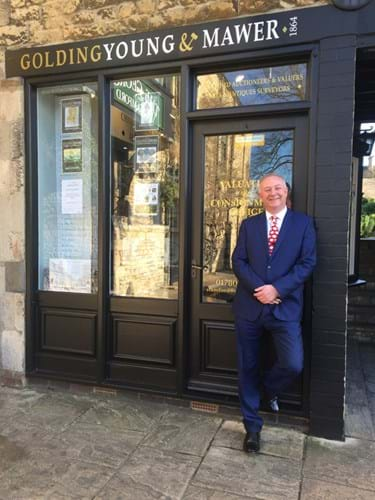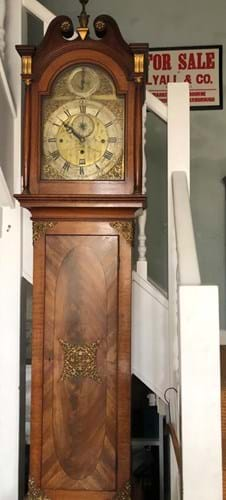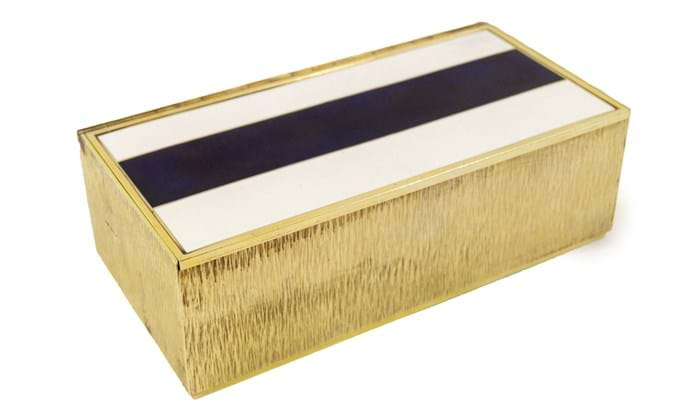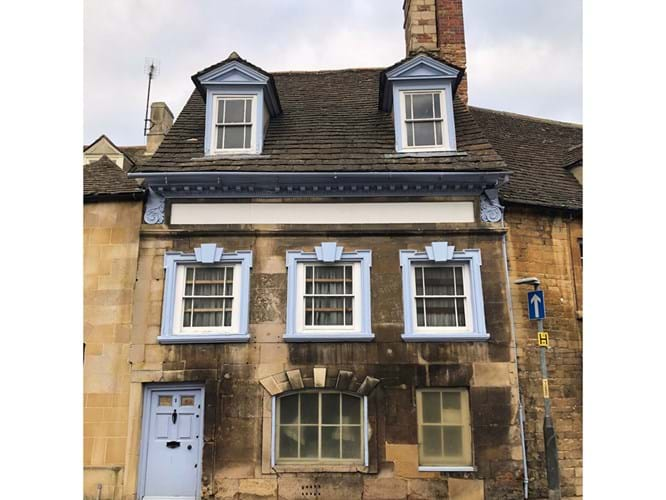
Picture this: a warehouse in Lincolnshire packed to the rafters with furniture by some of history’s best-known English makers.
Many of the clocks, cabinets, mirrors, tables and chairs greeting Lincolnshire auctioneer Colin Young were covered in dust and cobwebs, but no matter: the commission to sell the stock and personal collections of Stamford-based antiques dealers Gavin Burns and his son Ross was a dream one.
“I’d never seen a collection of furniture and objects at this volume, quality and combination before,” recalls Young, managing director of Golding Young & Mawer.
In the warehouse, at least two sets of chairs by Gillows jostled for space with pieces by George Hepplewhite, John Cobb, Thomas Sheraton, Ince & Mayhew and those attributed to George Smith and George Oakley.
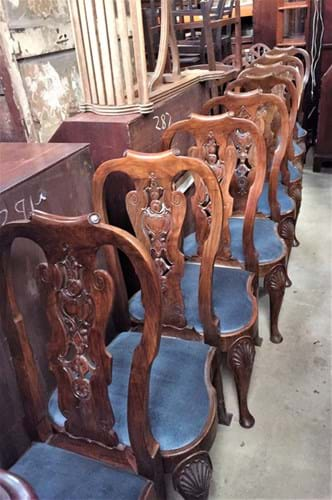
One of at least two sets of Gillows chairs in the St George's Collection for sale on April 24, pictured here in the Burns' warehouse ahead of cataloguing.
No reserve
This was to be no vanity sale by grand dealers on their retirement.
The instruction to Golding Young came with some stipulations: no glossy catalogue with personalised message from the dealers was required and strikingly, nor were reserves for each and all of the 800-plus lots in the sale. “I was told it was all here to sell,” says Young.
Prospective buyers will include knowledgeable dealers, says Young, so no need to guide with estimates either. “They’ll be guided by their own instincts,” he says.
Fresh to market
There are two schools of thought about dealer auctions. Some buyers may regard sales of dealers’ stock negatively, as ‘not fresh’, on the grounds that the objects have already been on the market. Others view dealer stock sales in a positive light, in that the material has been selected by an expert eye.
Young stresses that a proportion of the lots were from the Burns’ own homes and he created and published videos to prove this.
The Burns’ appreciation of fine furniture – several of the key lots have original invoices included – worked both ways, he says, and not only ensured quality stock. They loved what they bought so much, “there are many things that they never considered offering for sale. They retained some of the finest examples for their own personal enjoyment and decorative furnishing of their own homes, which are also being offered in this sale.”
Lots will be sold on one day, April 24, in eight sections, including separate groups of oak, walnut and mahogany furniture dating from the 17th century onwards.
Here are five highlights from the collection.
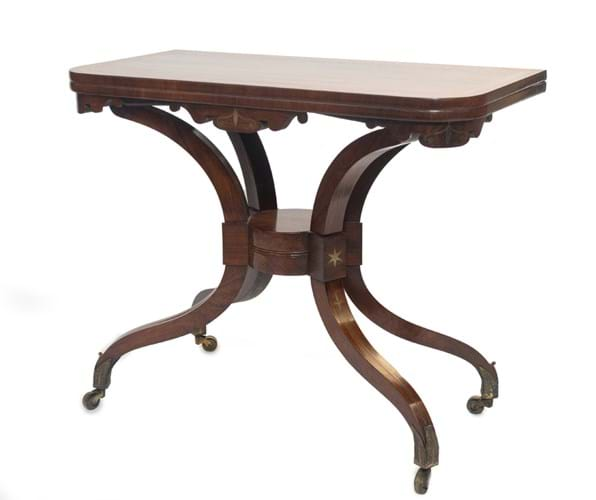
This Regency rosewood card table is thought to be by London cabinet maker George Oakley (1773-1840) .
Lot 75: Regency rosewood card table attributed to George Oakley
This 3ft (91cm) wide Regency rosewood card table is thought to be by London cabinet maker George Oakley (1773-1840) and has a distinctive scissor-action opening mechanism. Baize lined, the rounded rectangular fold-over top has satinwood crossbanding, scrolling frieze with brass inlay.
The serpentine legs have brass star and fleur-de-lis detailing and terminate in cast brass acanthus capped castors.
Oakley’s furniture, made in Regency-era Grecian taste, had a royal following. His firm had a Royal Warrant and today a pair of similar card tables are in the Music Room at Buckingham Palace, which may have been purchased by Queen Mary (1867-1953).
Lot 301: A George III mahogany longcase clock by Thomas Rayment of Stamford
That the St George’s Collection has strong local provenance is nowhere more evident than in this longcase clock by Stamford clockmaker Thomas Rayment.
Standing at 7ft 7in (2.49m) high, close inspection of the clock’s detail suggests it will be the stand-out lot among the sale’s clocks and barometers section, which features some 50 makers including Dolland of London.
The 30cm-square arch dial, for instance, has a subsidiary seconds dial and date aperture, engraved with floral decoration and the maker's script, Rayment Stamford.
The clock’s eight-day movement strikes a single large bell, chiming nine graduated bells.
Its flame-veneered trunk door has applied ormolu mounts, with amorini mask and floral spandrels on each corner, matched to the base with cast loop handles with shell backs, on bracket feet.
The team at Golding Young & Mawer unearthed several documentary references to father Thomas and son John Rayment as reputed 18th century watch and clockmakers in Lincolnshire and Cambridgeshire, including advertising from 1775, 1778 and 1786. The Rayment family are noted in Lincolnshire Clock, Watch and Barometer Makers by Wilbourn & Ellis (2001), and in Stamford Clocks & Watches by Laurence Tebbutt (1975).
Lot 1001: An Elizabeth II jewellery casket by Gerald Benney
The St George’s Collection is dominated by Georgian and Regency furniture and objects but there are some 20th century highlights.
Hull-born Adrian Gerald Benney (1930-2008) was the first British craftsman to hold four Royal Warrants simultaneously (from 1974-80) as a maker of objets de vertu in silver, gold and enamel.
Influenced by minimalist Scandinavian design, Benney became one of the most innovative goldsmiths of the 20th century’s second half. As he once noted: "My philosophy as such is to project and involve my own personal design theme without too much reference to others in the field."
This Elizabeth II silver gilt and enamelled table jewellery casket dates from 1972 and has the textured bark finish fashionable in the late 1960s and early 70s. The lid features two bands of white enamel and a central stripe of blue striated enamel, with a piano hinge and an interior lined with antelope skin.
At 2in (20.5cm) wide, 2.6in (6.6cm) high and weighing 50.5oz, the casket is stamped GERALD BENNEY, LONDON to the plain foot enclosing a textured base.
Lot 1002: George II silver lemon strainer by William Justis, 1742
Orange or lemon strainers, particular to the 18th century, were practical objects – with one or two handles – made to span the rim of a punch bowl and used to filter pulp and seeds from fruit juice being poured into a mix of alcohol and spices.
This large George II silver lemon strainer by William Justis (London 1742) has a pierced bowl of circular design with two open scrolling loop handles. It weighs 9 troy oz and the bowl measures 5.5in (14cm) diameter.
William Justis (also known as Justus, Justice and Justise) was apprenticed to John Fawder in 1712, then to Richard Bayley in 1718. He gained his first hallmark circa 1731 and a second in 1739. His son William was apprenticed to him in 1747.
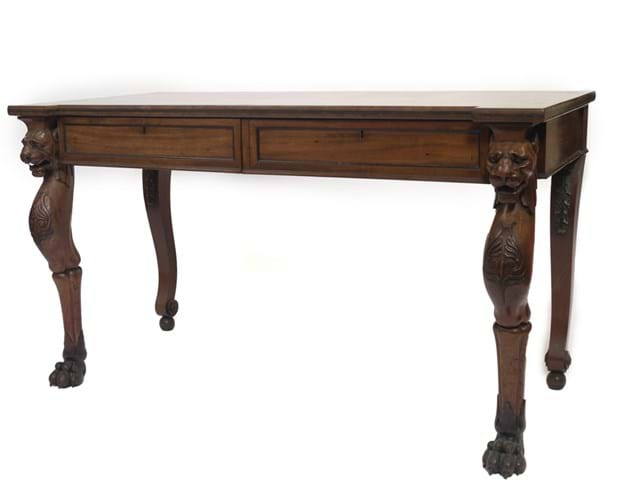
Several elements of this Regency mahogany serving table suggest it is by George Smith (1786-1826), favourite cabinet maker and upholsterer to the Regency aristocracy and the Prince Regent himself.
Lot 50: Regency mahogany serving table in the manner of George Smith
George Smith (1786-1826), favourite cabinet maker and upholsterer to the Regency aristocracy and the Prince Regent himself, was founder of the eponymous furniture business still in existence today.
Several elements of this table suggest it is by Smith. Its design includes component parts listed in Smith’s own pattern book, published in 1808: ‘A collection of designs for household furniture and interior decoration in the most approved and elegant taste’, in which Smith proudly declares himself to be ‘Upholsterer Extraordinary to His Royal Highness the Prince of Wales.
Smith made extensive use of classical forms in his furniture. Perhaps the most striking feature of the table are the monopodia legs with leopard’s heads, with Smith's signature stylised knee carving.
The table is 4ft 9in (1.45m) long, 2ft 8in (82cm) high and 2ft 6in (76cm) deep. It has a provenance to Sir Terence Sydney Airey KCMG, of Fritton, Norfolk.
Sir Terence was Allied Commander and Governor of Trieste 1947-1951, Commander British Forces in Hong Kong, 1952-1954.
As a highlight of the St George’s Collection sale, this table is coming home, albeit temporarily: it was lot 580 at Golding Young’s August 2006 sale, when it was consigned by T C S Brooke, a BADA dealer in Wroxham and bought by the Burns.


